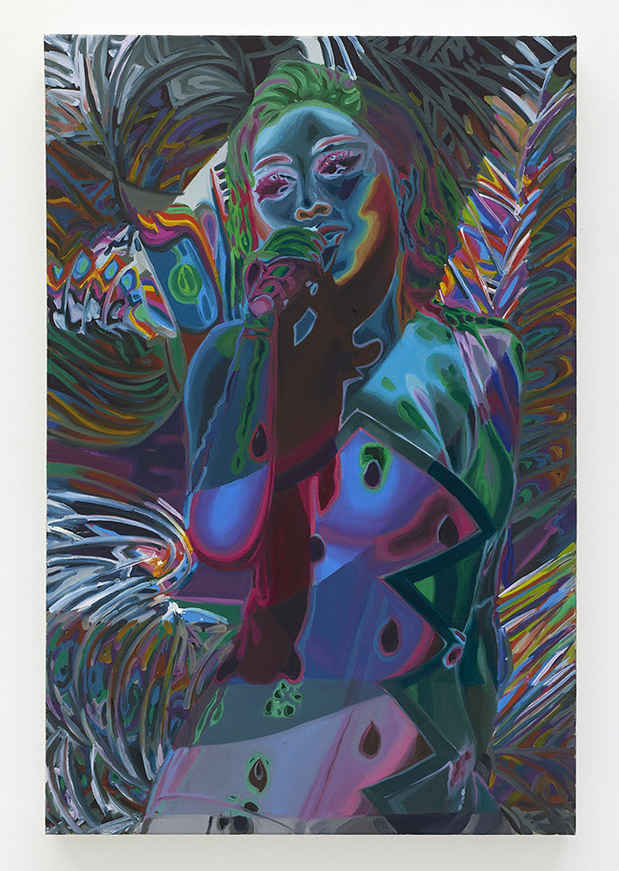“Density Betrays Us” Exhibition
The Hole (86 Walker St.)

This event has ended.
Curated by Andrew Woolbright, Angela Dufresne, and Melissa Ragona
The Hole presents “Density Betrays Us” a guest-curated exhibition by Andrew Woolbright, Angela Dufresne and Melissa Ragona. Developing out of a 2020 article by Andrew in Whitehot Magazine, “Phantom Bodies”, this theme and many of the artists exhibited began with thinking about the body in the digital age. Seeing artworks that treat the skin like a computer “skin” questions our ideas about corporeality, weight or even gravitas. In the words of the curators:
The body has entered a realm of endless modification and anonymity—producing endless persona, worlds of saved games and respawn points. The works featured in Density Betrays Us conflate and confound figure and ground, individual and mass, weight and weightlessness, and visual and non-visual elements and events. Less interested in skin as an organ, than as an image-average, this exhibition excavates how surface—as force, as affect— is activated across several contemporary projects. To borrow from Gilles Deleuze, Spinoza’s idea of “spiritual automata” was a convincing way to present “our power of acting or force of existing.” The latter exists, he argues, in a continuous line of variation. The complex surfaces and body-oriented works of this exhibition embrace such dissimilitude, cutting across the incongruities of mediated translations.
As initially articulated in Woolbright’s “Phantom Body: Weightless bodies, Avatars, and the End of Skin” the body, specifically its canonical depiction as flesh, is being re-imagined in post-humanist terms.* Many contemporary artists represented here have left the physical body behind and exchanged it for variable virtual models. Emma Stern downloads open-source 3D models of young girls, overtly sexualized by their anonymous designers. Stern takes these models and attempts to give them personhood, naming them and introducing them into invented environments. At times they are chimeric —as in the work of Carl D’Alvia and Chris Coy—integrating animals and objects into their own 3D skin in a way that is in line with Donna Haraway’s concept of a Cyborgian hybrid being. Similarly, there is Didier William, who is using paint to reinvestigate what seems like the glistening, weightless environmental landscapes of early World of Warcraft games. Their low-res limitations are transformed by the material sensations created from dripping paint over carved wood panels- treated with such gravitas, detail, and commitment that we are forced to consider them as organic and social realities rather than as ephemeral effects.
Density Betrays Us also presents artists who explore the figure dematerializing in or folding into the landscape (and vice versa), as in the work of Joiri Minaya, Peggy Ahwesh, Sun Yitian, William E. Jones and Michael Robinson. Starting back as early as William Blake, who wanted his figures to appear hollow to advance his concepts of ecology or moving forward to Jacob Lawrence who tracked black bodies in transit—joined through kinetic color, moving, seemingly without conventional density—through a racist, troubled landscape, the artists presented here create spaces where figure and ground are sometimes grafted to each other, at other times, interdependent, but almost always— in constant motion. The background and foreground of Angela Dufresne’s work shimmer, undulate, forming phenomenological meshes. Figuration is developed by the negative space it inhabits. The figures and landscapes are at times indecipherable, ecological; creating an electric force that charges the surfaces of her paintings. Or Nicole Miller’s video work which highlights the physical effects of social and political realities, while operating as portals for escape, invocation and revelry. Caitlin Cherry similarly shows a body affected by its environment, and her work floats between the sensual body and the sonic as she flexes her expert handling of color, camouflage, as well as visual and social noise.
Finally, we must remember that the term “digital” was already used in the 15th century. It referred to calculations or “cuts” that could be done using ten fingers, a knowledge understood at the edges of one’s body. In step with earlier innovations, we have included a master of corporeal intensities, the great Italian artist Carol Rama (1918-2015). Her work builds on, but moves beyond realistic representations of the body, or to borrow from Paul Preciado, she “irreverently incorporates a visceral, bodily sensibility into the history of modern painting, while injecting industrial and profane implications into its scope.” As avatars, chimeras, as kinetic force fields, the works in this exhibition challenge conventional notions of figurative art, tied as it is to positivist ideas about presence, subjectivity, and materiality. The work of these artists rejects canonical, patriarchal histories of portraiture, reaching beyond representations of a neo-liberal subject into worlds where bodies become open systems of affect, gateways to new technological forms of being-in-the-world.
Media
Schedule
from June 29, 2021 to August 14, 2021
Opening Reception on 2021-06-29 from 18:00 to 20:00